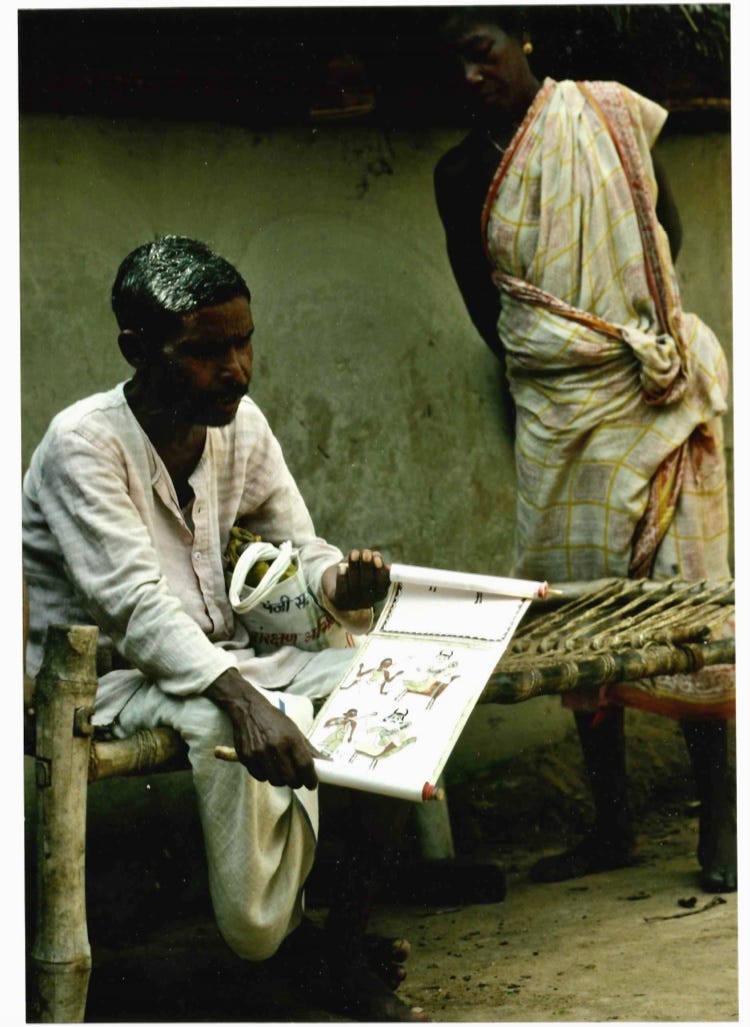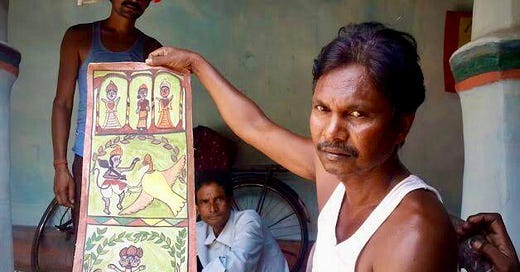Welcome to the Brown History Newsletter. If you’re enjoying this labour of love, please do consider becoming a paid subscriber. Your contribution would help pay the writers and illustrators and support this weekly publication. If you like to submit a writing piece, please send me a pitch by email at brownhistory1947@gmail.com. Check out our Shop and our Podcast. You can also follow us on Instagram and Twitter.
Jadopatia: The Dying Art of India's Santhal Tribe by Konkana Ray
Bashudev Chitrakar, a practitioner of the Jadopatia art form, narrates the creation myth of the Santhal chitrakar: “When the elder son of Pilchu Haram and Pilchu Burhi died, the couple cried inconsolably. Tribal God Marang Buru came and told them not to cry as he would do something for them. From a ball of dirt on his forehead, he created the first chitrakar. The Chitrakar asked- why did you create me? God replied- the son of Pilchu Haram and Pilchu Burhi has died, you shall go there, make a chitra (picture), of the son and take the dan (salary). The chitrakar then asked: but how shall I make the eyes that give life? God blessed him with special powers to paint the eyes.” This is how the Santhal mortuary ritual of ‘Cokhodan’- gift of the eye, began.
Folklore traditions have been an essential component of all cultures. From over 2000 years to a few decades ago, itinerant picture storytellers travelled throughout India, using painted picture scrolls to spread a wealth of enthralling stories and folklore about regional Gods, local heroes, morals and mythology, amongst the rural populations. In the hands of these painters and singers, the picture scrolls served as a portable cinema, projection screens for mythical knowledge with an incentive to listen to entertaining songs whilst viewing the scrolls.
Political changes, social turmoil and technological innovation in the twentieth century ushered in profound changes to audio-visual art forms. As their tradition lost significance, the Indian scroll-painting artists also lost their audience and their means of livelihood. One such folk art form that narrated exciting mythological tales but is in terminal decline is Jadopatia.
In the Eastern Indian state of Jharkhand, there exists a small guild of scroll painters and performers known as Jadopatias. Jadopatia scroll painting is a traditional art form of the Santhal tribal society of India. It is a unique and mythological visual presentation in the world of tribal folk art. From time immemorial to the pre-independence era, Jadopatia enjoyed its own value in Santhal villages.
These paintings were created by male artists known as ‘Chitrakars’. Even though the term ‘Chitrakar’ means picture-maker, the art involves a form of audio-visual performance in which the bard narrates a story in song while exhibiting a painted scroll. In the traditional world of chitrakar performance, the painted scroll was used as a prop—to aid the bardic narration serving the same objective as pictures in illustrated storybooks for children. The song anchored the pictorial story as it guided the painter on how to render the visual scenes. These compositions help art historians analyze and understand the narrative universe within which the Chitrakars worked. Over time the space for bardic performance has shrunk and artists have shifted their attention solely to the painted scrolls.

Every folk art form brings forth a dense history with social and political plenitude. Folk art imagery reflects upon the stories of marginalized and minority cultures. It is a product of a nexus of relations and transactions, constituted through networks of encounter and exchange over centuries. Similarly, the Jadopatia art form is typically associated with primitive techniques of making art for the primitive tribes surrounding their stories and beliefs. The socio-cultural narratives that chitrakars saw and heard around them were finely painted on the scrolls using a simplified form. With minimal colours and natural materials, the Jadopatia Painters of Santhal Parganas are the true embodiment of the modern-day philosophies: minimalism and naturalism.






